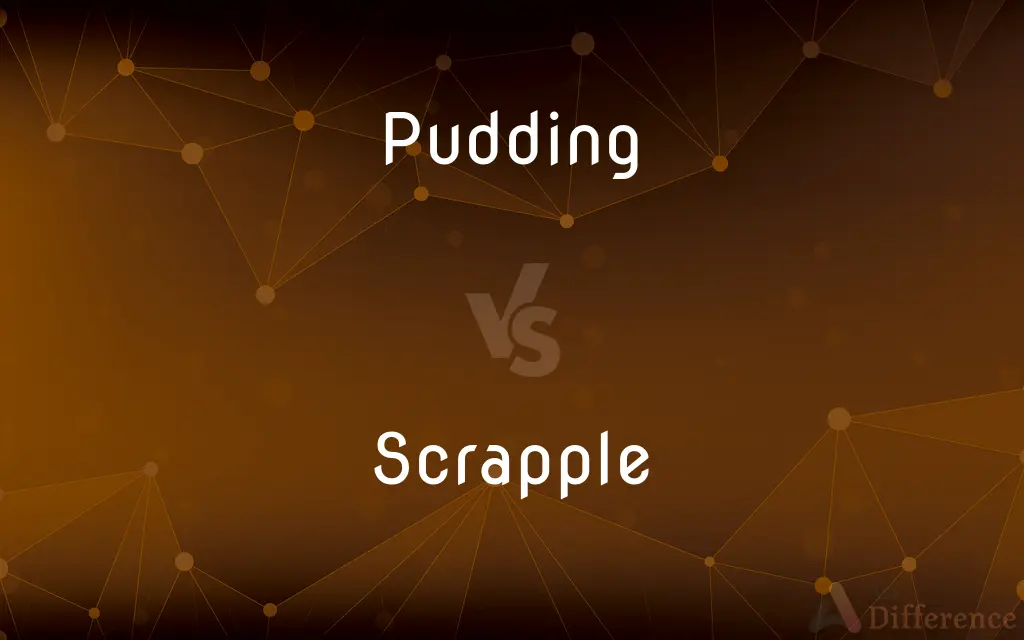Pudding vs. Scrapple — What's the Difference?
By Maham Liaqat & Fiza Rafique — Updated on March 29, 2024
Pudding is a sweet dessert made from milk, sugar, and a thickener, often flavored; scrapple is a savory loaf made from pork scraps and cornmeal, fried before serving.

Difference Between Pudding and Scrapple
Table of Contents
ADVERTISEMENT
Key Differences
Pudding, a dessert that varies from creamy textures to dense, cake-like forms, often incorporates flavors such as vanilla, chocolate, or fruit. It's traditionally made by combining milk, sugar, and a thickening agent, like cornstarch or eggs, which gives it a smooth, creamy consistency. Scrapple, on the other hand, originates from Pennsylvania Dutch cuisine and is a savory dish. It is made by boiling pork scraps with spices, then mixing with cornmeal and flour to form a mush. This mixture is then allowed to solidify into a loaf, which is sliced and fried before serving.
Pudding is popular in various forms around the world, ranging from the soft, custardy versions to firmer, baked varieties. Puddings can be served as a final course to a meal, highlighting their sweet, rich flavors. Scrapple is known for its crispy exterior and soft interior, offering a unique texture combination. It's often enjoyed for breakfast, accompanied by eggs or syrup, showcasing its versatility in savory meals.
While pudding is celebrated for its sweet and creamy qualities, scrapple is appreciated for its savory flavor and unique texture. Pudding is typically served as a dessert or sweet treat, making it a favorite for those with a sweet tooth. The process of making pudding involves careful heating and often chilling, resulting in a dessert that's both comforting and indulgent.
Scrapple, with its origins in utilizing leftover pork scraps, represents a tradition of resourcefulness in cooking. It combines meat with grains to create a filling, economical dish that's been a staple in certain regions. The preparation of scrapple, from boiling to frying, adds layers of flavor and texture, distinguishing it from the simplicity of pudding's preparation.
Comparison Chart
Type
Dessert
Savory dish
ADVERTISEMENT
Main Ingredients
Milk, sugar, thickener
Pork scraps, cornmeal, spices
Texture
Creamy or dense
Crispy exterior, soft interior
Flavor
Sweet, varies with ingredients
Savory, meaty
Serving Time
Typically served as dessert
Often served for breakfast
Compare with Definitions
Pudding
A sweet, creamy dessert made with milk and sugar, thickened with agents like cornstarch.
Vanilla pudding is a popular choice for a light dessert.
Scrapple
Known for its crispy exterior and soft interior.
He preferred his scrapple well-browned and crispy.
Pudding
Can refer to dense, cake-like desserts in British English.
Christmas pudding is a traditional end to the holiday meal.
Scrapple
Often served with eggs or maple syrup.
They enjoyed scrapple and eggs for a hearty breakfast.
Pudding
Often flavored with chocolate, vanilla, or fruit.
Chocolate pudding is a favorite among children.
Scrapple
A savory loaf made from pork scraps and cornmeal, fried before serving.
Scrapple is a traditional breakfast item in Pennsylvania.
Pudding
Served either warm or cold, depending on the recipe.
Cold rice pudding makes a refreshing summer treat.
Scrapple
Represents a tradition of resourceful cooking.
Making scrapple was a way to use up all parts of the pig.
Pudding
Known for its smooth texture and rich taste.
Homemade caramel pudding was the highlight of the dinner party.
Scrapple
Features a unique combination of textures and flavors.
The savory taste of scrapple was a perfect contrast to the sweet maple syrup.
Pudding
Pudding is a type of food that can be either a dessert or a savory (salty or spicy) dish that is part of the main meal.In the United States and Canada, pudding characteristically denotes a sweet, milk-based dessert similar in consistency to egg-based custards, instant custards or a mousse, often commercially set using cornstarch, gelatin or similar collagen agent such as Jell-O. The modern American usage to denote a specific kind of dessert has evolved over time from the originally almost exclusive use of the term to describe savory dishes, specifically those created using a process similar to that used for sausages, in which meat and other ingredients in mostly liquid form are encased and then steamed or boiled to set the contents. Black (blood) pudding and haggis survive from this tradition.In the United Kingdom and some of the Commonwealth countries, the word pudding is still used to describe both sweet and savory dishes.
Scrapple
Scrapple, also known by the Pennsylvania Dutch name Pannhaas or "pan rabbit", is traditionally a mush of pork scraps and trimmings combined with cornmeal and wheat flour, often buckwheat flour, and spices. The mush is formed into a semi-solid congealed loaf, and slices of the scrapple are then pan-fried before serving.
Pudding
A sweet, soft dessert, often with a base of milk or cream thickened by flour, cornstarch, or a cereal product, that has been boiled, steamed, or baked
Chocolate pudding.
Rice pudding.
Scrapple
A mush of ground pork and cornmeal that is set in a mold and then sliced and fried.
Pudding
An edible mixture with a soft, puddinglike consistency
Corn pudding.
Scrapple
A tool for scraping.
Pudding
A sweet dish eaten at the end of a meal; dessert.
Scrapple
A mush of pork scraps, particularly head parts, and cornmeal or flour, which is boiled and poured into a mold, where the rendered gelatinous broth from cooking jells the mixture into a loaf.
Pudding
A sausagelike preparation made with minced meat or various other ingredients stuffed into a bag or skin and boiled.
Scrapple
To scrape or grub around.
Pudding
Any of various dishes, sweet or savoury, prepared by boiling or steaming, or from batter.
Scrapple
An article of food made by boiling together bits or scraps of meat, usually pork, and flour or Indian meal.
Pudding
A type of cake or dessert cooked usually by boiling or steaming.
Pudding
A type of dessert that has a texture similar to custard or mousse but using some kind of starch as the thickening agent.
Pudding
Dessert; the dessert course of a meal.
We have apple pie for pudding today.
Pudding
(originally) A sausage made primarily from blood.
Pudding
(slang) An overweight person.
Pudding
(slang) Entrails.
Pudding
(obsolete) Any food or victuals.
Pudding
A piece of good fortune.
Pudding
A species of food of a soft or moderately hard consistence, variously made, but often a compound of flour or meal, with milk and eggs, etc.
And solid pudding against empty praise.
Pudding
Anything resembling, or of the softness and consistency of, pudding.
Pudding
An intestine; especially, an intestine stuffed with meat, etc.; a sausage.
Pudding
Any food or victuals.
Eat your pudding, slave, and hold your tongue.
Pudding
Same as Puddening.
Mars, that still protects the stout,In pudding time came to his aid.
Pudding
Any of various soft thick unsweetened baked dishes;
Corn pudding
Pudding
(British) the dessert course of a meal (`pud' is used informally)
Pudding
Any of various soft sweet desserts thickened usually with flour and baked or boiled or steamed
Common Curiosities
Do puddings have to be refrigerated?
Yes, most puddings, especially those made with dairy, require refrigeration to maintain freshness and prevent spoilage.
Can pudding be savory?
While pudding is generally sweet, some cultures have savory versions, but these are less common than the sweet varieties.
Is scrapple only eaten for breakfast?
Though traditionally served for breakfast, scrapple can be enjoyed at any meal, offering versatility in savory dishes.
What spices are used in scrapple?
Common spices in scrapple include sage, black pepper, and thyme, contributing to its savory flavor profile.
How is scrapple prepared?
Scrapple is made by boiling pork scraps with spices, mixing with cornmeal and flour, forming into a loaf, then slicing and frying.
What is pudding made of?
Pudding is made from milk, sugar, and a thickener like cornstarch or eggs, often flavored with vanilla, chocolate, or fruits.
Can pudding be frozen?
Yes, many types of pudding can be frozen, though the texture may change upon thawing.
How do you know when scrapple is cooked properly?
Scrapple is cooked properly when it has a crispy exterior from frying, with a fully heated and firm interior.
Can pudding be vegan?
Yes, pudding can be made vegan by using plant-based milks and thickeners instead of dairy and eggs.
Is pudding healthy?
Pudding can be part of a balanced diet in moderation, though it's often high in sugar and calories.
Is scrapple gluten-free?
Traditional scrapple contains flour, making it not gluten-free, but there are recipes that substitute gluten-free grains.
What's the origin of scrapple?
Scrapple originates from Pennsylvania Dutch cuisine, representing a tradition of using all parts of the pig.
What's the difference between pudding and custard?
Pudding is thicker and often eaten with a spoon, while custard is usually thinner and can be used as a sauce or filling, with eggs as a key ingredient in custard.
How long can pudding be stored?
Homemade pudding should be consumed within 5-7 days when stored properly in the refrigerator.
Can scrapple be made without pork?
While traditional scrapple is pork-based, variations can use other meats or even vegetarian substitutes.
Share Your Discovery

Previous Comparison
Content vs. Contents
Next Comparison
Good vs. WellAuthor Spotlight
Written by
Maham LiaqatCo-written by
Fiza RafiqueFiza Rafique is a skilled content writer at AskDifference.com, where she meticulously refines and enhances written pieces. Drawing from her vast editorial expertise, Fiza ensures clarity, accuracy, and precision in every article. Passionate about language, she continually seeks to elevate the quality of content for readers worldwide.















































